Prime rib is usually for a special occasion. And admittedly it can be a little stressful with all the pressure to get it right: the guests, the expensive roast, the expectation of restaurant-level perfection. And sure, prime rib at a restaurant is really good, but you can do way better at home, and save a bunch of money. This method for smoked sous vide prime rib is stress-free.
Cooking prime rib only in the smoker is a favorite of mine, and absolutely amazing. But I wanted to experiment to see if I could improve on that. The results were even better than I had hoped for, and this two-step sous vide BBQ method has some solid advantages.
We’re bringing two cooking methods together for the ultimate prime rib. It’s the most tender and perfectly cooked thanks to sous vide, and it’s the most flavorful thanks to the smoker. The two just work so well to cook absolutely perfect medium-rare from top to bottom with savory smoky flavor and a delicious crust.
We’re essentially doing all the cooking via sous vide, and then really just warming it back up in the smoker while absorbing all that amazing smoke flavor.
Why You’ll Love this Method
- Take advantage of the science, technology and magic of sous vide to guarantee that the prime rib is perfectly cooked all the way through. No guessing, and no gray ring along the outside.
- Allows a more hands-off cook. My initial reason for trying this was that I needed to smoke a prime rib, but I also had my kid’s birthday, and I didn’t want to worry about monitoring the smoker all day.
- You still get the tremendous smoked flavor and awesome bark, with less time in the smoker and at a lower temperature.
- Precise control over your preferred doneness. You can even split the roast into two and cook differently for multiple preferences.
- Stress-free, which is a huge bonus.
- So tender! A rib roast is already tender by nature, but this brings it to another level.
To Smoke or Sous Vide First?
There’s a lot of debate on whether you should cook the meat sous vide first, or smoke first then sous vide. Both sides have some valid points and reasons for doing it the way they do.
Raw meat can take on more smoke and form bark more easily than cooked meat, which is a reason to smoke it first. However, that is going to get washed away (including a lot of the smoke flavor) when it cooks in the water bath inside a vacuum-sealed bag.
My preference is to first sous vide the meat, then smoke it. By cooking sous vide first, it is perfectly cooked and is fully chilled down and left wet so it is ready to attract flavorful smoke. The result has been wonderful every time I have tried it.
Sometimes people smoke, sous vide and then smoke it again. This is totally overkill and way more work than it’s worth. Especially since one of the advantages of sous vide is that it’s hands-off most of the time.
Tools & Equipment Used
Here’s a list of the exact tools & equipment I used to make this.
- Vacuum sealer
- Vacuum-seal bags
- Anova Sous Vide Cooker Pro (Love the Wi-Fi version for longer cooks so you can monitor remotely.) The cheaper Anova Nano works great, too.
- 12-quart water container
- Sous vide weighted magnets to keep the bag submerged in the water.
- Sheet pan and a wire rack
- Large cutting board
- Boning knife and a slicing knife
- Butcher twine to tie the rib roast and make it a uniform round shape.
- Weber Smoke Fire EX4 Pellet Smoker
- Drip pan to place in the smoker.
- Pellets – Went with Green Mountain Texas Blend because my preferred wood for beef is oak. If you are using a charcoal smoker like the Big Green Egg, then about 3 post oak wood chunks would be perfect.
Prepping the Rib Roast
Planning ahead is key. This isn’t like throwing a steak on the grill and being done in 10 minutes. We are going to be working over the next 2 to 3 days on it (hands-off almost the whole time).
Prep the rib roast at least 24 hours before it heads into the water bath. Use a very sharp knife to trim the excess fat and fat cap down to 1/4”, then score the fat cap with a cross-hatch pattern using a sharp knife. My preference is to use a boneless rib roast, so remove the rib bones if desired.
Season with 1 teaspoon of Diamond kosher salt per pound of meat 24 to 72 hours in advance. Use butcher twine to tie the roast into a uniform round shape. Place on a wire rack on top of a baking sheet and place in the refrigerator uncovered.
After the dry-brine time has passed, it can be vacuum-sealed. If it is too large to fit in your vacuum seal bag, you can cut the rib roast in half crosswise and use two separate bags. Then it’s ready for the 6-to-12-hour sous vide cook.
The Dry Rub
After the sous vide, we’re adding a simple, yet important dry rub before the roast heads into the smoker. We have a beautiful premium piece of beef here, and we really want to taste it, being careful not to overpower it with a rub. Most of the seasoning was done with salt a few days in advance. The dry rub, however, is important for helping to develop bark as it smokes, and it will add some flavor, so don’t overpower it.
I don’t add a dry rub to the rib roast for the sous vide part of the cook, but you totally can if you want. Most of it will wash off during the cook.
Be careful of salt in dry rubs, as we already salted the beef in advance. A little more on the surface won’t hurt, but we don’t want it to be over-seasoned.
For this one, I didn’t use a specific recipe. I just threw together a quick rub that consisted of coarse ground black pepper, smoked paprika, garlic powder and a little granulated sugar. A little sugar will help develop nice bark in the smoker. You really don’t have to use a rub if you don’t want to, but I would definitely add pepper for balance.
The Smoker Setup
For this cook, I went with the Weber Smoke Fire EX4 pellet smoker for the ease and convenience of pellets and Wi-Fi connectivity for monitoring remotely.
We want the temperature low, so we can add smoke flavor without overcooking the already perfectly cooked rib roast.
- Use an indirect cooking setup (keep the meat away from the direct heat source).
- Put a drip pan with a few inches of water underneath where the rib roast will be placed. This adds humidity to the environment that attracts smoke, and keeps your smoker clean.
- Place a remote probe thermometer in the center of the roast.
- Use Super Smoke / Smoke Boost mode for the first 1 1/2 hours. This mode is a low temp (180-200° F) with extra smoke found on the Weber Smokefire and Traeger smokers.
How to Make Smoked Sous Vide Prime Rib
- Prep the prime rib. The first step is to clean up the rib roast and season it early, at least 24 hours in advance, but preferably 48 hours (and up to 72 hours). This will allow the salt to penetrate all the way through the large roast, bringing out all the amazing flavor and making it more tender.
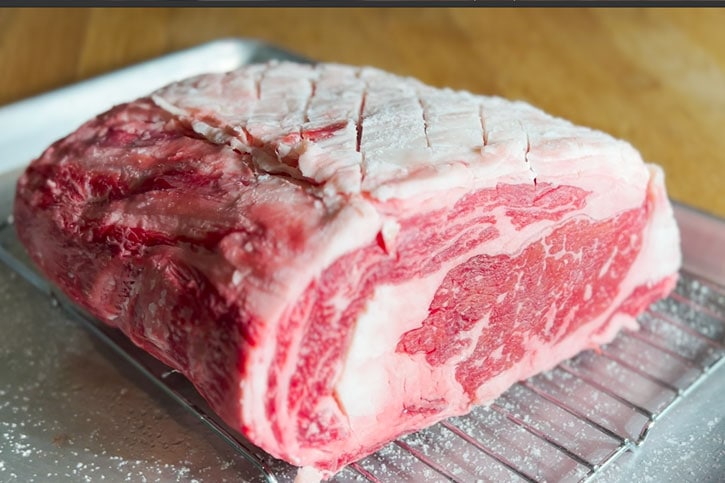
- Sous vide the rib roast. The second step is to cook the rib roast sous vide. Vacuum seal and place in a 133° F water bath (for medium-rare) for a minimum of 6 hours and up to 12 hours. *I cooked this 6 1/2 pound boneless rib roast for 10 hours.
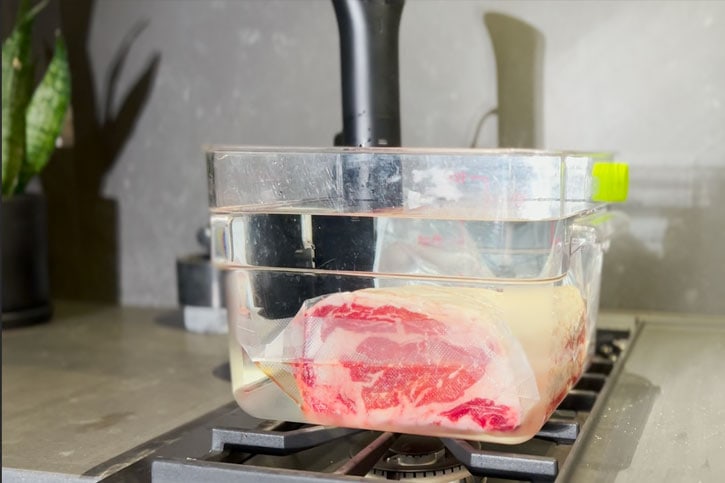
- Chill it. Place the still vacuum-sealed rib roast in an ice bath to fully chill it. You can also refrigerate overnight or for longer before smoking. Since we’re going to smoke it, we want it cold so it doesn’t overcook.
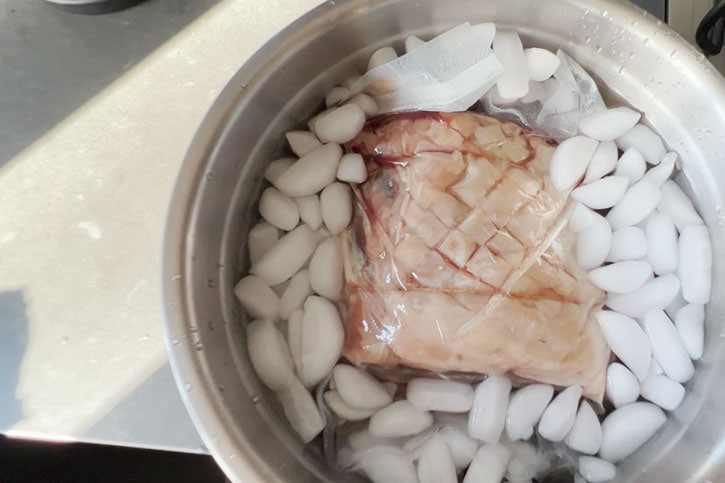
- Apply a dry rub. Remove the rib roast from the bag, keeping it wet, which will act as a binder to keep the dry rub on the surface, as well as attract smoke. Apply a light coating of your favorite simple dry rub, or just go with some pepper if you prefer.
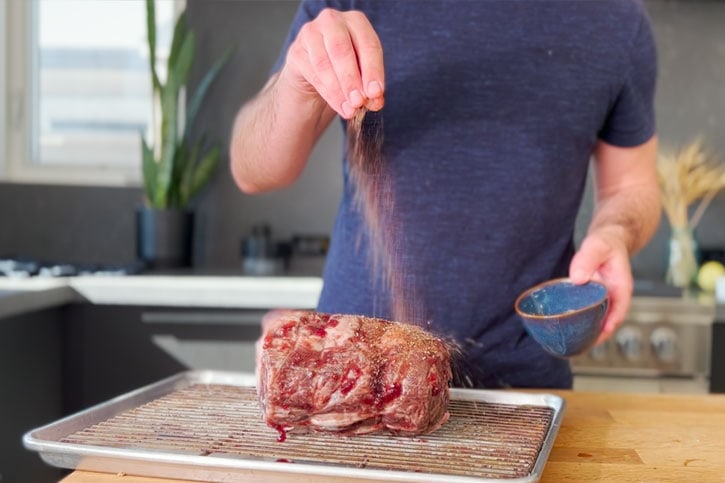
- Smoke it. Finally, it’s time to add that wonderful smoke flavor and develop the bark on the outside. We’re not actually cooking it in the smoker; we’re really just warming it through back to the temperature at which we sous vide it.
With a probe thermometer inserted into the middle of the roast, place it into a smoker on the lowest temperature setting, around 180-200° F with the Smoke Boost / Super Smoke mode activated if using a pellet smoker (which is what I used for this). This will provide the most smoke without raising the temperature of the roast too quickly.
Smoke it for 1 1/2 hours, then raise the temperature of the smoker up to 225° F until the internal temperature of the roast climbs to 130° F. This was about 3 hours total in the smoker for me. If it is taking too long, you can increase the temperature of your smoker to 250° F.
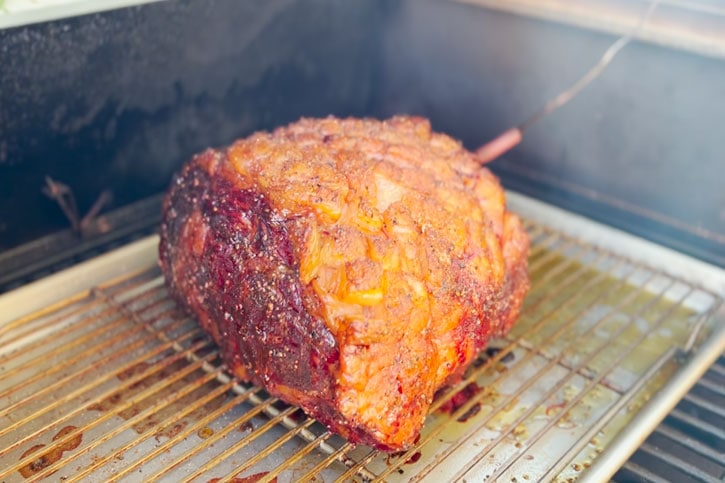
- Sear it. Remove from the smoker and either sear the fat cap with a blow torch, on a hot grill, in a skillet or under the broiler for 1 to 2 minutes just to crisp up the top. *When I was making this, I didn’t sear it and wished I had.
- Slice it and serve after a 15-minute rest. Slice against the grain into 1/2” to 3/4” slices.

Tips
- Plan ahead, and season early, then cook sous vide a day before you plan on smoking and serving it. Just keep it vacuum-sealed in the refrigerator.
- You can split the rib roast into two parts if it won’t fit in your bags. You can also cook each piece separately if you want different doneness (e.g., one medium-rare and one medium).
- Buy an entire rib roast (usually cheaper per pound). Break it down into steaks at different thicknesses and a large portion for your prime rib. Freeze what you don’t need and save the rest for later.
- Slicing – Since this is likely for a special occasion, you want to be served a wholesome portion and a little thicker is better (1/2″ to 3/4″ thick) and always against the grain (across the roast).
You can’t overcook it in the traditional sense. It won’t cook beyond the temperature of your water bath, but it will continue to get more tender. But it can become mushy if you were to cook it for a day or longer.
You don’t need to rest the sous vide prime rib once it is out of the smoker, but you do need to chill it completely before you smoke it.
Six to 12 hours is a good window. This one was sous vide for 10 hours.
133° F is perfect for medium-rare doneness.
The prime rib will smoke for about 3 hours until it comes back up to the original cook temperature, but it depends on the starting temp and size of your roast, along with the temperature of your smoker.
More Delicious Smoker and Sous Vide Recipes
- Smoked Sous Vide Pulled Pork
- Smoked Sous Vide Pork Ribs
- Smoked Sous Vide Chuck Roast
- Smoked Tri-Tip
- Smoked Prime Rib
- Sous Vide Steak
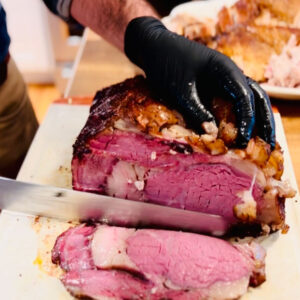
Smoked Sous Vide Prime Rib
Ingredients
- 4 to 10 lb boneless rib roast
- 2 Tbsp Diamond kosher salt (1 tsp per pound of meat)
- dry rub
- pellets or wood chunks for smoking
Instructions
Prep the Rib Roast (24 to 72 hours before sous vide)
- Trim the excess and fat cap down to 1/4" using a sharp knife. Cut a cross-hatch pattern in the fat cap, being careful not to slice the flesh.
- Season all sides liberally with 1 teaspoon of Diamond kosher salt per pound of meat. Optional but recommended is to tie the roast with butcher twine so it maintains a nice round shape. Place on a rack on top of a rimmed baking sheet and refrigerate uncovered for 24 to 72 hours.
Sous Vide the Rib Roast
- Vacuum seal the rib roast or place in a 2-gallon Ziplock bag and use the water displacement method to remove the air and seal.
- Place in a 133° F / 56° C water bath (for medium-rare) and fully submerge for a minimum of 6 hours and up to 12 hours. **I cooked this 6 1/2-pound boneless rib roast for 10 hours.
- Place the still vacuum-sealed rib roast in an ice bath to fully chill it before smoking. You can also refrigerate overnight or for longer before smoking. Since we’re going to smoke it, we want it cold so it doesn’t overcook.
Smoke the Rib Roast
- Set up your smoker for indirect heat cooking with your favorite pellets or wood chunks at a low temperature at or below 200° F with a drip pan with a few inches of water below where the meat will be placed. Use the Super Smoke / Smoke Boost mode if using a pellet smoker.
- Remove the rib roast from the bag, keeping it wet, and apply a dry rub on all surfaces.
- Insert a probe thermometer into the middle of the roast and place it into a smoker. Smoke for 1 ½ hours, then raise the temperature of the smoker up to 225° F until the internal temperature of the roast reaches 130° F. This was about 3 hours total in the smoker for me. If it is taking too long, you can increase the temperature of your smoker to 250° F.
Sear the Rib Roast and Serve
- Remove the rib roast from the smoker and either sear the fat cap with a blow torch, on a hot grill, in a skillet or under the broiler for 1 to 2 minutes just to crisp up the top.
- Slice it and serve after a 15-minute rest. Slice against the grain into ½” to ¾” slices.
Video
Notes
- Any size rib roast can work for this. Mine was about 6 1/2 pounds and boneless.
- Oak wood is my preference, but hickory also works great.
- Slice against the grain into 1/2″ to 3/4″ portions just before serving.
- You can sous vide the roast up to 3 days ahead of time before finishing in the smoker.

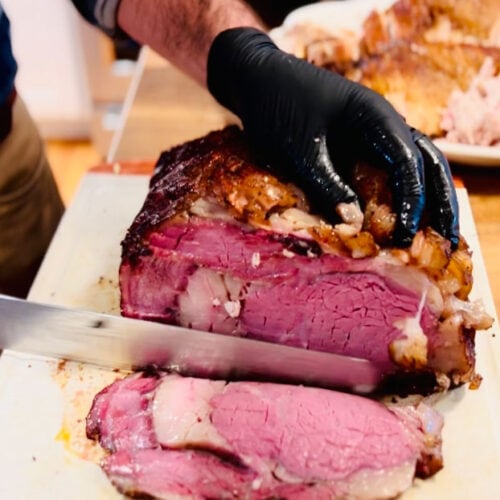

I’ve done a number of corned beef / Pastrami and Texas Briskets using this method but was not sure if it would work as well with Prime Rib. I’m so glad to see that other than time and temp. everything else is the same. I’ll be setting this up for a dinner next week. Thanks for the reassurance that this is the right path to go down.
Cooked to absolute perfection. This method is the best! It’s not the shortest process but it is super easy and totally worth it. Our guests at Christmas were amazed by how it turned out.